Kaplan is one of the oldest USMLE prep courses, with thousands of medical school students subscribing to it every year across the world. This popularity is largely due to Kaplan’s long history as a successful USMLE prep resource, resulting in high pass rates for its students. While the impressive success record of the course is a great point to note, given its high price point (4-5x compared to its peers) it is worth asking if the course is the best option in the market, especially with other cheaper alternatives (such as Med School Bootcamp) available now. This guide will review the Kaplan course and give an unbiased review.
What we will cover?
An Overview of What We Liked and Disliked
Before we get into details, here is a brief summary.
Kaplan USMLE Review
- Extensive Video Lessons: If you are weak with concepts or need a thorough revision, video lessons are helpful.
- Comprehensive Question Bank: One of the largest question banks with exam-like questions, frequently updated by medical faculty and former NBME writers, and accessible via a mobile app. It covers both high and low-yield topics.
- Structured Learning Platform: An organized online platform offering diagnostic assessments, practice questions, videos, and full-length practice exams, supplemented with lecture notes.
- Flexible Study Options: A variety of course formats including live, live online, and on-demand, along with shorter quizzes, diagnostic tests, and a full-length simulation exam for most courses.
- Bundle Offers: Kaplan Medical’s Plus Programs allow students to bundle different course formats for a reduced price.
- Mobile App: A user-friendly mobile app compatible with iPhone and Android devices, offering on-the-go access to practice and review questions.
- Courses for International Students: Specialized courses for international medical graduates, including additional online courses for the residency application process, interview preparation, and understanding of US medical residency.
- Comprehensive coverage of topics. It is helpful if you are weak in basics or an international student.
- It is an affordable program compared to other programs offering live classes.
- If your basic concepts are weak, then Kaplan USMLE would be a great fit for you.
- The course offers several hundred hours of live classes with great instructors
- Their simulated exams are very realistic, similar to exam questions
- Several thousand practice problems with well-explained answers
- The digital platform is very user-friendly, and they have a mobile app for easy access
- Kaplan has a lot of lower-yield questions that rely heavily on strict rote memorization. So, there is a risk of getting overwhelmed by too much information.
- No integrated flashcards (unlike Med School Bootcamp).
- The user interface of the Kaplan question bank and video quality leave much to be desired.
- Price is on the higher side for on-demand courses.
- No pass or money-back guarantee
Which Kaplan USMLE Prep Course is Right For You?
There are two-course formats for each of the three steps of Kaplan. There are on-demand courses and live online courses. Additionally, there is a third option, an instructor-led class on-site in New York, which is not as popular as the on-demand and live classes, so we will focus on the first two.
If you are someone who is disciplined enough to follow a study schedule, on-demand class option is suitable for you. But, if you are kind of person who learns much faster with live classes and would like to forced to follow a schedule Live Class is a good option.
On-Demand Classes
The On-Demand plan is the most flexible option and is suited for students with busy schedules or self-motivated and displayed students who want to manage their studies. The on-demand course is a self-study option and can be accessed from anywhere.
The On-demand course includes video lessons, tons of Qbank practice questions, answers to the questions with explanations, simulated exams, and print/e-book resources. The number of lecture hours you receive and the practice questions you get depend on the specific step of the exam for which you are preparing.
On Demand package costs $2000 in Step 1, while Steps 2 and 3 cost $1200 and $900, respectively.
Comparing these prices to other USMLE prep course providers, these costs are high, especially for self-study plans. So, if you are working with a tight budget, you might get other better options such as Med School Bootcamp.
Live Classes
The second option is the Live Online plan, which offers features and study material similar to the On Demand package. Additionally, this plan includes live classes, which are essential, especially for learners who prefer studying in real-time.
The classes include live classwork. Step 1 package offers more than 270 hours of live class, as step 2 offers 210+ hours of live classes, and you get more than 100 hours with step 3. These live classes also come with a lot of instructions. You will pay more for the Live Online study plan, understandably so. Steps 1, 2, and 3 will cost $400, $4000, and $1700.
Kaplan USMLE Course Detailed Overview
Diagnostic Test
Once you login, you get a quick introduction videos at the start and a diagnostic test. These videos are simply a welcome to the course. They explain how each step of the plan works and sheds light on some strategies. Overall, the videos are basic and straightforward and give you a general overview as they point you in the right direction. Then, there is the diagnostic test. This test is shorter compared to the real full-length exam. Its role is to get baseline knowledge of what you know and the weak areas you might be struggling with. After identifying your weak points, you can then proceed with the lesson material.
All you need to do is do the things described in front of you as per the study plan and follow the provided steps. Their study plan is very clear and will walk you through what you need to ensure you study in an organized way and in the right order.
The coursework is organized according to the USMLE topics. Each topic has subtopics, which then dictate the basis of your study modules.
Each study modules have 3 different parts. You are given estimated study time for each part (top right corner) so that you can easily plan your schedule.
- Foundations
- Integrated Plan (High Yield topics with subtopic quiz)
- Assessments (Sectional Quiz)
Once you are done reading the reference material, you can take some warmup questions.
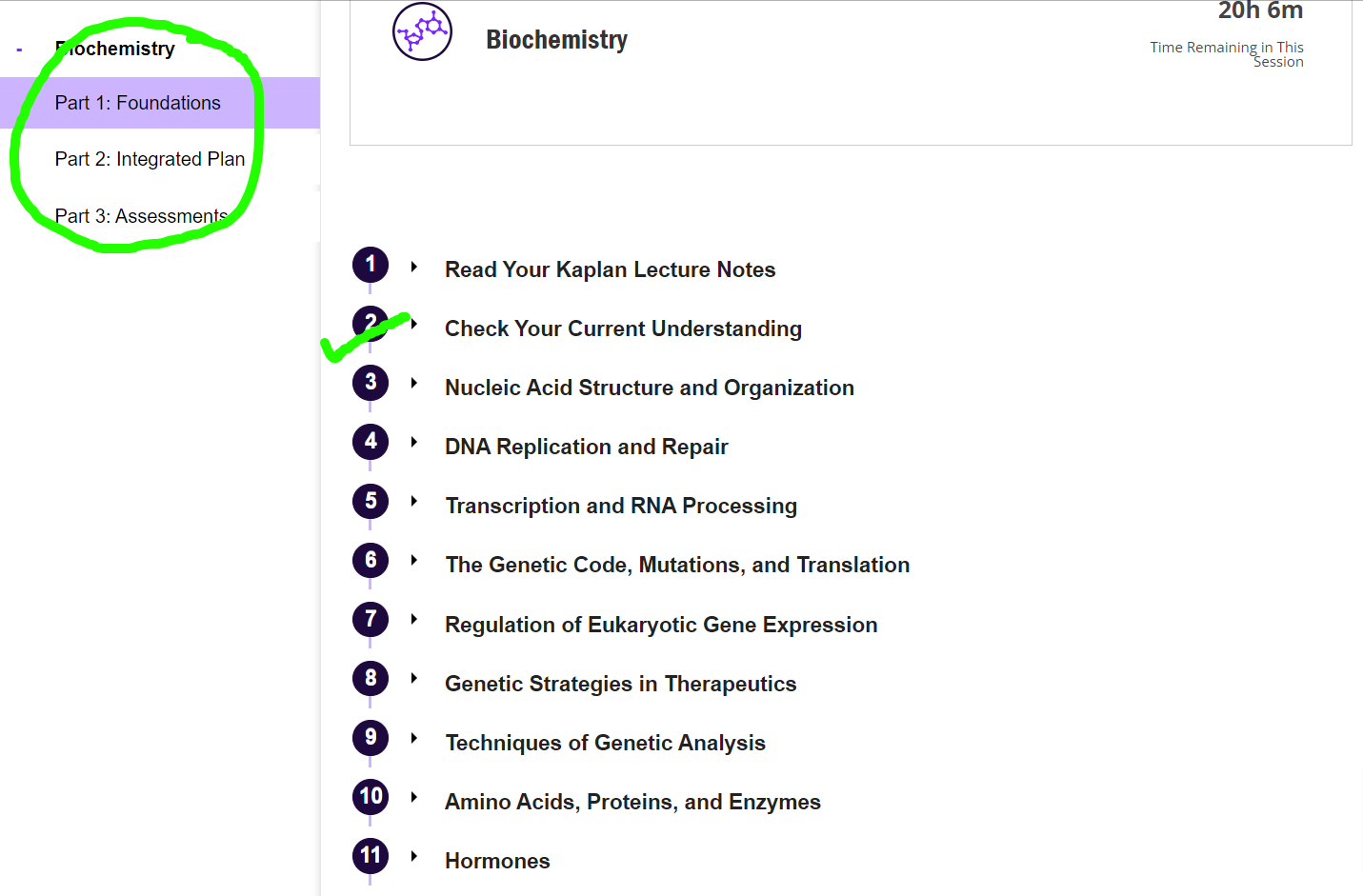
Usually, there are five questions, and they are more straightforward than exam questions.
While they may not be similar to a real exam, they do a great job of testing your knowledge and assessing how much you know. Once you are done with the quiz, you need to take on a series of more video lessons covering a narrower subject matter. The videos will depend on the topic and can be a few minutes or more than an hour. Usually, how long the lecture video takes depends on the contents, but they are all informative and add value to your understanding.
The videos appear similar to a PowerPoint video format. Here, the lecturer will be giving the lesson verbally, and there will be some slides on the screen. As they continue speaking, the slides roll on the screen, and the lecturer makes notes on the side. Some of the videos (rarely, though) cut to an instructor. However, most of them feature slides relevant to the topic on the screen and the instructors’ lectures over them. The slides are mostly visual eg graphics, illustrations, tables, etc.

We found this impressive because, besides being informative, they keep the lectures engaging compared to how it would have been if they were solely text slides. The visuals are also great for students who learn better through visuals.
The on-demand videos, I must say, were highly informative and well thought out. However, having taken other similar courses to this, I would not say they were the most exciting. The videos may be informative, but they do not have a wow factor. So, while the course material is well thought out, the predictive value is somewhat underwhelming. Also, the picture quality can be significantly improved. Either way, the course delivers what it should- the content is quite comprehensive.
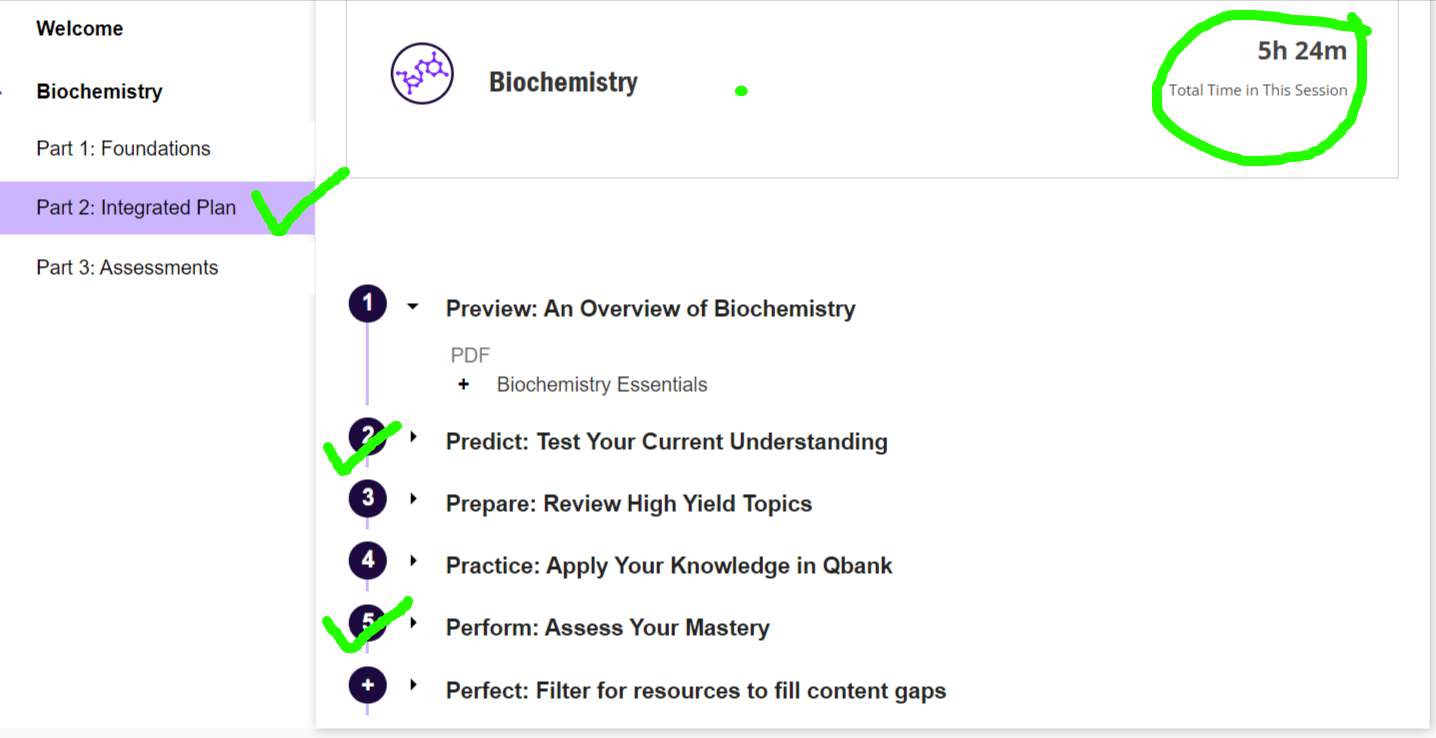
Afterward, you also get to do quizzes based on what is covered in the videos’ quizzes are a maximum of ten questions, and they test what you recently learned through the videos. The question styles are not similar to exam questions. They tend to be simpler and, thus, go quickly. After taking the quiz, you get to review your answers. For the questions you have gotten wrong, there are some explanations to help you learn before moving to study the next subject. So, the study plan is well-thought-of because you go from one topic to another.
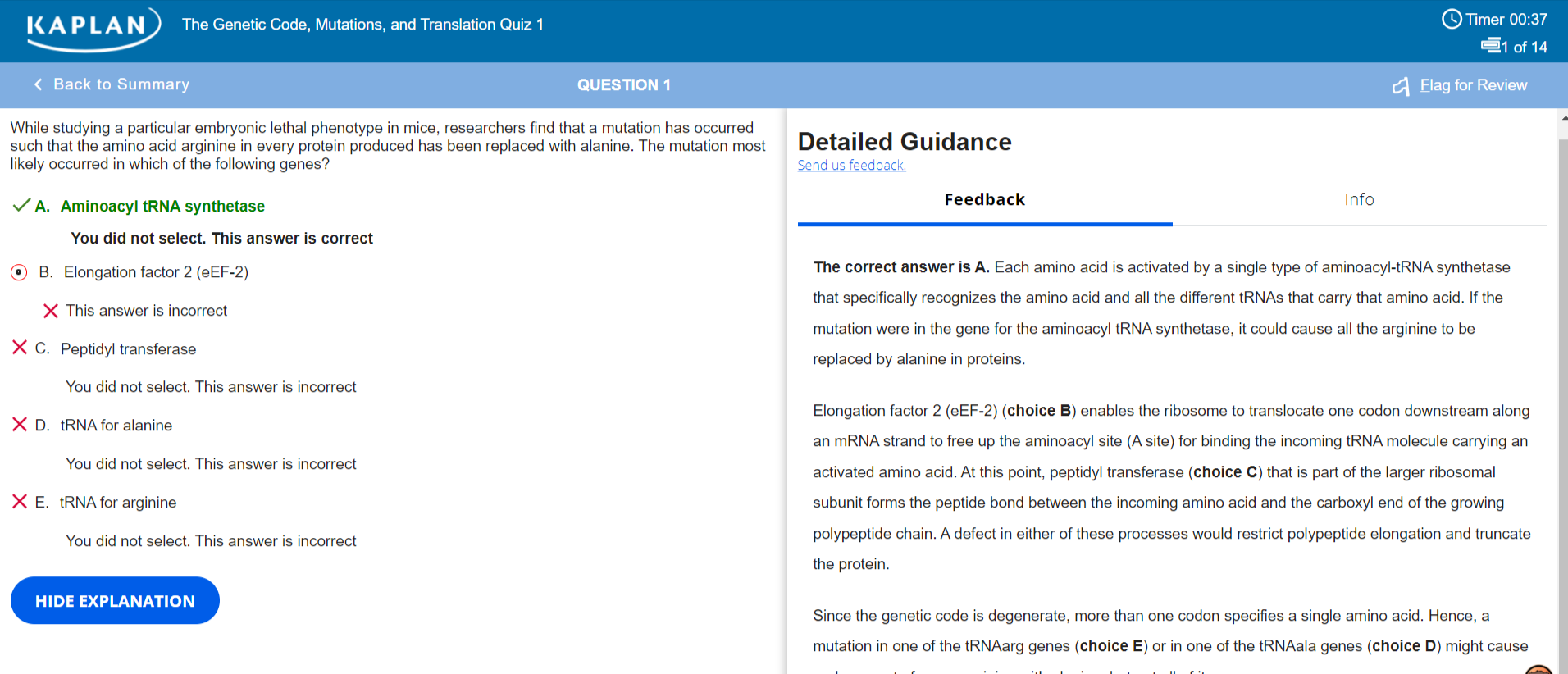
At the end of each topic, you get a section test which is typical 1-1.5hrs long to test your preparedness for that section.
Question Bank
Kaplan grants the users access to some exam-simulated practice questions on Qbank. For step one, there are 3,300 questions, 2,900 questions for step two, and 900 for Step 3.
There are a lot of practice problems involved for each step. But, for this case, let us focus on step 1. Overall, Kaplan’s Step 1 course is similar to its competitors, like Board Vitals. You can create quiz according to the area of your focus.

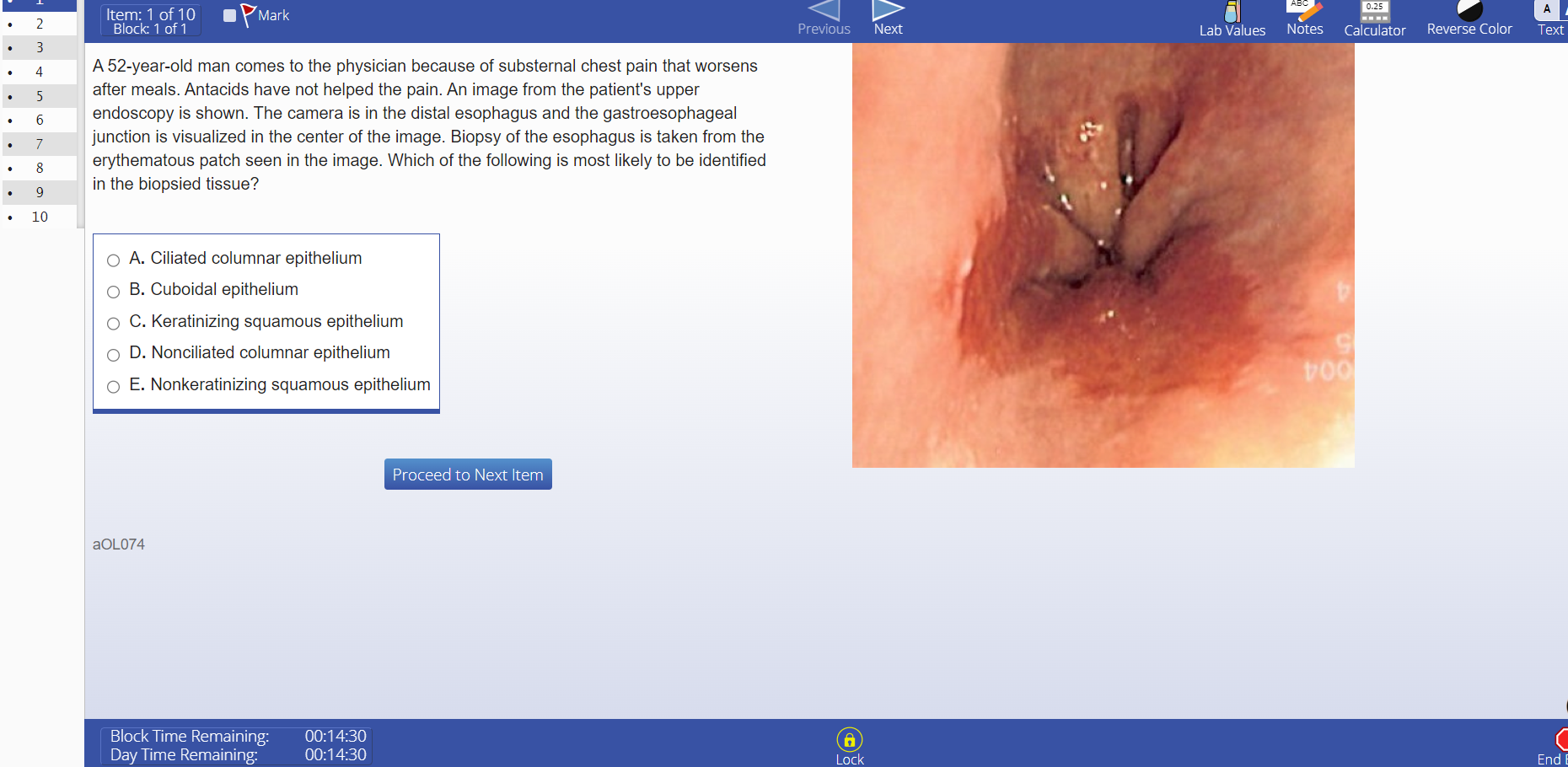
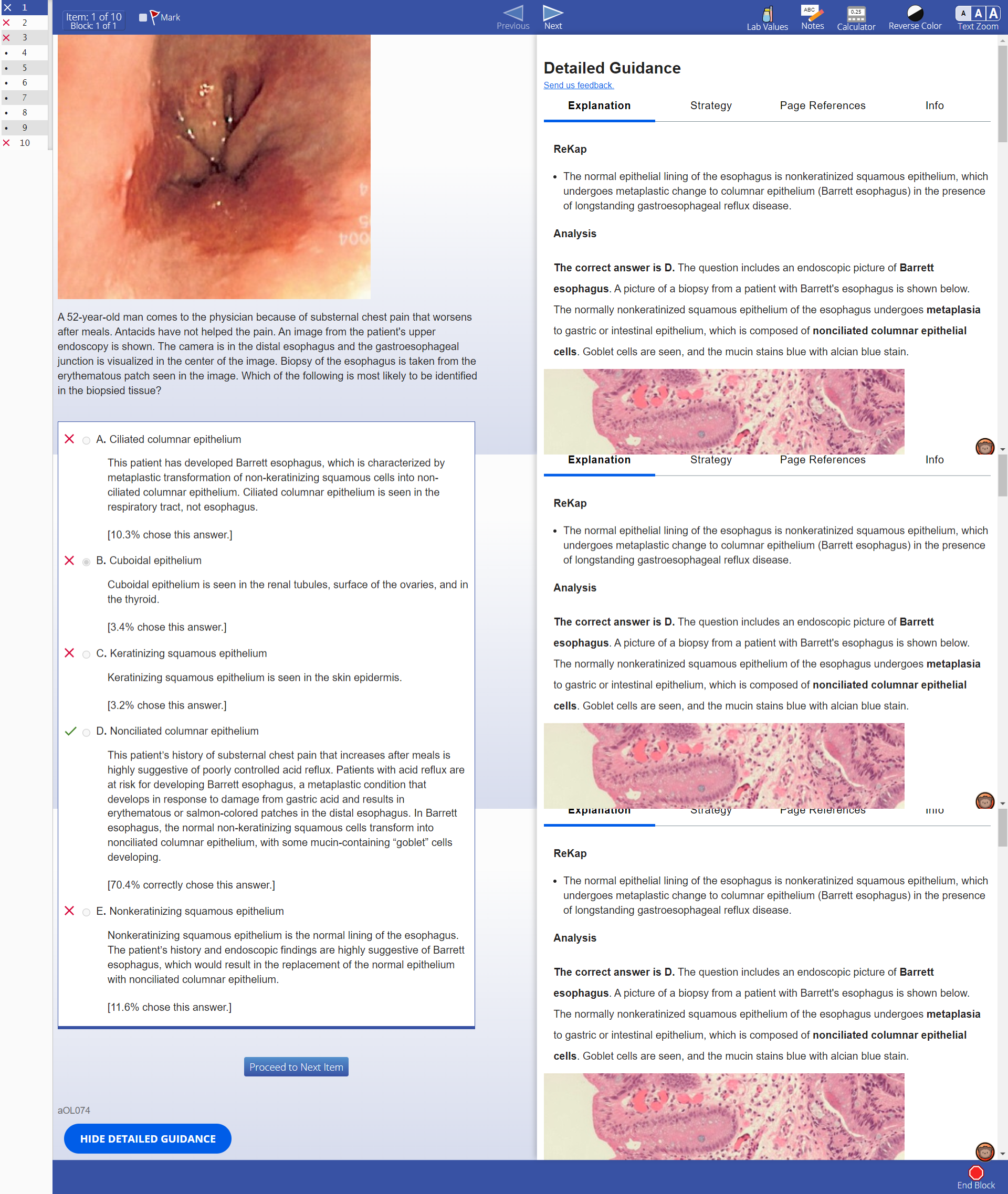
Kaplan’s questions are similar to USMLE official questions, and they do a great job of familiarizing yourself, so you know what to expect on the test day. Their questions fully explain the underlying concept, with some content review and detailed analysis for each answer.
However, some of these text explanations contrast with the quiz question explanations, and I think there is room for Kaplan to improve. But, Kaplan has a lot of lower yield questions that rely heavily on strict rote memorization. So, if you have limited time, UWorld might be better option. The user interface of the Kaplan question bank leaves much to be desired. It lacks the functionality to cross out answers and the text size is disappointingly small.
Nevertheless, I was impressed by the Kaplan curriculum. Their coursework is very effective, their study plan is well-thought-out, and they cover all the necessary exam topics. I still emphasize that they can do a lot to improve the quality of their video lessons.
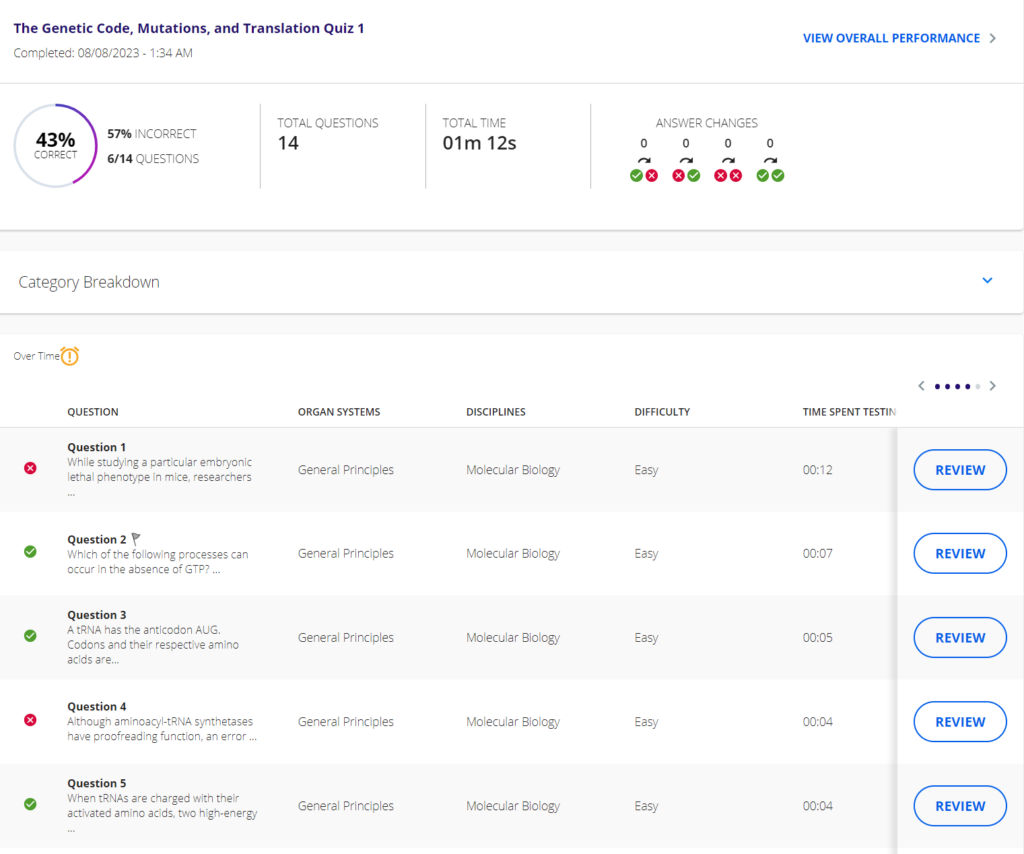
Practice Tests
If you sign up for the Step 1 or 2 Kaplan USMLE Prep course, you will have access to 2 full-length simulated exams. They are full-length and similar to a real test experience; you will take them in exam-like conditions. These exams come in intervals, one as a midterm test and the other as a final after you are done with the prep course.
I would say these tests are fairly accurate and are almost similar to the USMLE exam. I found the Qbank questions to be helpful as well because they are an accurate representation of the exam. For the practice tests, I would say Kaplan has done a great job mimicking both Step 1 and 2 exams down to the interface.
Regarding Kaplan Step 3, you will take 56 specialty assessments. They are not full-length exams as with those in the other two steps, understandably so because it would be hard to replicate the exam experience. So, instead, you get shooter assessments to help you prepare for the exam.
The Live Online Classes
Kaplan live classes can be rivalled only by PASS Program Live classes in terms of quality.
When taking the Step 1 course with hundreds of hours of live classes, the team of instructors would take turns. It also seemed like Kaplan invested in the instructors and did find the subject matter expert for each topic, which is thoughtful and underrated.
Most of the lecture instructors were knowledgeable and delivered their topics in an exciting way. Nonetheless, there were a few boring lectures, but they still had great knowledge of the topic. It is just their style of delivering the content was less engaging. Aside from that, the instructors are masters in the subjects they took up and great communicators. Remember, the USMLE material can sometimes be bland, and they did invest their time and effort to make it enjoyable.
When you enter the live class sessions, the instructors will often ask the class some questions in random polls, so you will not zone out mid-lesson. They also allow you to ask questions through the chat function, which I would say is helpful because I used it a few times,
I found the classes to be a bit long. Although they are only a few hours long, the instructors delivered a lot of strategies, material, and concepts during the lessons. And, it was a lot to take in. Almost all the time, at the end of the live class, my brain was fried, and I believe other learners’ brains were too. But a tired, exhausted brain is always a sign that you have learned something new. Overall, the classes deliver value for the money.
Kaplan Prep Books
One thing I would say I loved most about the Kaplan course is the prep books they give you. Studying for an exam can be hectic, and the neat organization of these textbooks makes it easy to learn and retain what you learn.
The volume you get, again, depends on the step you are taking. For Step 1, students will receive a 7-volume set. Meanwhile, Kaplan gives a 5-volume set for Step 2 and a 2-volume set for Step 3 test takers.
Their books are very resourceful. They are detailed, thoughtfully written, and include a lot of visuals-images, tables, and graphics. So, even visual learners enjoy these books as the visuals demonstrate any visual processes, organ systems, and other important key points. These books are also well organized, styled, and focused on the point. Their outline format is also great, which makes them fact-driven, concise, and easy to understand.
All in all, after reviewing various courses, I can confidently say these books are among the best in the USMLE prep courses. There are no unnecessarily long or rambling sections as with other voluminous books. They are great for both textbook and visual learners.
Kaplan USMLE Tutoring
There is a lot in store for students who prefer live online classes. Alongside the classes, you will also access their 1-on-1 tutoring, which is excellent additional support for the course. You will also have access to an advisor who can help you plan your study. The advisor will talk you through issues you may be facing and challenges. They will also help with explanations to answers for some substantive questions and share some test-taking strategies to make your learning more effective.
In my case, I did not see these little sessions to be as helpful as they could because they do not go as deep as other tutoring I have done for students in the past. However, I appreciate the presence of a tutor and the thought of cashing alongside the classes.
I believe students need to hear from someone who understands what they are going through because they have been there themselves. This advice feature may serve as a great support function, and this is a course element that I love.
How Long Do I Access the Course Content?
The content access period you get depends on your chosen package and the step. For example, if you subscribe to the On Demand package, you will have an access period of about four months, but for Step 3, it will be three months of access. However, these durations are not written in stone, and it is possible to extend the period at an additional cost.
You can also choose to extend the access to between 4 or eight more months, but this flexibility will come at a few extra hundred dollars. However, the initial default 4-month period tends to be enough for most students preparing for their USMLE. But you will need to fully dedicate yourself to serious study during this period.
In comparison, when you choose to subscribe to the Live Online course, you will be cut off much faster. You will first be tied to the duration of your course because of the online classes. Although you might continue to access the materials after the class sessions, it will be for a limited amount of time.
Kaplan’s User Experience and Digital Platform
Among other courses I have reviewed, the Kaplan digital platform is among the easiest to follow. There is a navigation bar on the left side which directs the user to the resources, making it easy to navigate.
The user experience is great because the digital platform’s usability is easy, organized, and straightforward. You can either jump to the Qbank section, click on a topic lesson, the simulated exam, or anything else on the dashboard. You can also easily access the study resources under the “All Resources” tab.
Furthermore, the Kaplan portal has a great look and feel. It appears very sleek, clean, modern, and professional. I have encountered some clunky and outdated platforms, so it is clear Kaplan took a lot of time and put a lot of seriousness into their student portal.
The Step 1 Mobile App
Interestingly, Kaplan has a mobile app designated for Step 1 students only. Therefore, Step 2 and 3 subscribers do not have the app. I honestly don’t understand their reasons for this, but I would prefer having an app for all the steps.
The app gives Step 1 students access to Qbank but not to video lectures, which is a downside for the app. However, the video lectures are very mobile-friendly, and you can use the app conveniently to stream online classes at the convenience of your phone.
While it is a thoughtful addition, the app doesn’t necessarily offer an excellent platform for working on practice questions or reviewing explanations. But it is functional and well organized (and works well too!). You don’t have to worry about slow loading speed like other apps.
Is There a Pass Guarantee with Kaplan?
Most USMLE courses have such a guarantee, but, unfortunately, not with Kaplan. They neither offer a pass guarantee nor a money-back guarantee, which is more of a bummer given how much it costs. This might be a deal breaker for many students who are looking for the best USMLE prep course.
Bottom Line
From our experience with Kaplan USMLE, we can understand why students love this course and the high number of subscribers yearly. Kaplan offers a comprehensive curriculum, which is among the best compared to other USMLE prep courses.
Additionally, their study plan is cohesive and clear, which is rare in most courses. For the Kaplan tools and study resources, the live online classes are the highlights of the resources. Their lessons are detailed, and they use outline-style textbooks.
Moreover, the study material is unbeatable in the space, not to mention the realistic practice questions that are exam-like. The explanations following the Bank questions are also helpful and thoughtful. In all honesty, the quizzes and explanations following the warm-up questions were a little thin. As for the on-demand videos, the lectures were informative, as promised, and contained a lot of information. It may not be suitable if you have very limited time left or you have solid grasp over concepts and just need help in test taking strategy.
If you are
1) looking for comprehensive coverage of concepts and not sure about your basics
OR
2) an international student , Kaplan USMLE is a great fit.
Our experience with using Kaplan to prepare for the USMLE was positive. We loved the course because of how rich and informative it was. It features a nice user experience as well as great resources to use.
- High-Quality Extensive Video Lessons: If you are weak with concepts or need a thorough revision, video lessons are helpful.
- Comprehensive Question Bank: One of the largest question banks with exam-like questions, frequently updated by medical faculty and former NBME writers, and accessible via a mobile app. It covers both high and low-yield topics.
- Structured Learning Platform: An organized online platform offering diagnostic assessments, practice questions, videos, and full-length practice exams, supplemented with lecture notes.
- Flexible Study Options: A variety of course formats including live, live online, and on-demand, along with shorter quizzes, diagnostic tests, and a full-length simulation exam for most courses.
- Bundle Offers: Kaplan Medical’s Plus Programs allow students to bundle different course formats for a reduced price.
- Mobile App: A user-friendly mobile app compatible with iPhone and Android devices, offering on-the-go access to practice and review questions.
- Courses for International Students: Specialized courses for international medical graduates, including additional online courses for the residency application process, interview preparation, and understanding of US medical residency.
FAQs
Are Kaplan Questions good for Step1?
Yes. If you are learning the material for the first time, Kaplan provides reference to in depth materials.
Is the Kaplan USMLE Prep Expensive?
The cost will depend on the class format you would like and the step you need to study for, but it will range from $800 to $400.
Is Kaplan or Uworld better for USMLE Step1?
We found Kaplan practice questions more realistic compared to Uworld . Uworld’s detailed answer explanations are quite helpful.
Should I Get the Kaplan USMLE?
Yes, you should. From our experience, there is an excellent curriculum covered, and in a great way. Although there are a few downsides, they are very minor compared to the value you get.

Review Summary
User Reviews
There are no reviews yet. Be the first one to write one.
Share Your Experience